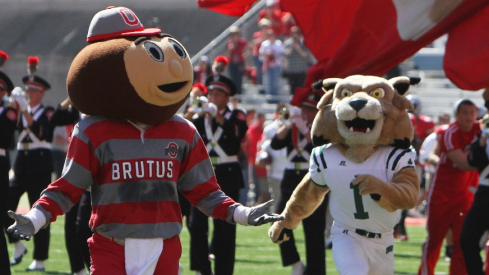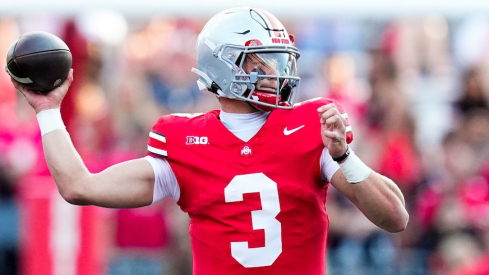
Last week we laid out the foundation of Urban Meyer's Ohio State offense. In short, it consists of using the quarterback as a run threat, thereby adding an additional offender the defense must account for and in so doing open up the base inside run game.
Today, I want to examine the next layer of Meyer and Tom Herman's offense.
The Buckeyes want to stretch the field horizontally. This pulls the defense's second level across the field and slows them down from crowding the box. The purpose is thus the same as using the QB in the run game — protecting the base run plays.
Stretch 'Em and Slow 'Em
Last week we discussed creating 'defensive end conflict.' The goal is to hold an unblocked defender against the run game and make a defense's most disruptive athletes play slow. Meyer & Co. want to next induce the same hesitation into a defense's second-level players.

The Buckeyes do so by using misdirection off their run plays in both the run and pass game. The first such method is jet sweeps.

Meyer runs the jet sweep action away from the base inside zone or gap blocking. This false keys the linebackers and ideally makes them a step slower when they see the base run action. And if they do not honor the jet sweep action then Meyer can give the football to a speedy player in space.

OSU also likes using inverted veer/power read for the same purpose but in a slightly different manner. The hope here is that the front side linebackers widen out with the sweep action, enabling the QB to follow the pulling guard through the hole.
Putting inverted veer aside, OSU used relatively few misdirection jet sweeps in 2012 because they did not have the ideal personnel to run the play. But the Buckeyes nonetheless successfully resorted to it late in the season, simply to prevent teams from keying on Braxton Miller. For instance, here OSU runs the tight zone away jet sweep arc block diagrammed in the upper right hand corner above.
Look for OSU to use such plays more frequently going forward as they get the personnel to make such plays succeed.
Keeping the D out of the Alley
A related method OSU uses to stretch the defense horizontally and protect its inside run plays is flash screens. Flash screens are thrown off inside/tight zone action. The goal is again to force the defense to honor the spread offense's established arithmetic.
Defenses like to cheat the slot defender into the alley between the receiver and tackle to regain an extra defender against the run. Though he is feigning accounting for the slot receiver, he is in reality playing the run. The defense can then have that defender account for the quarterback, giving them +1 inside the box versus the run game. The flash screen forces defenses to honor the immediate perimeter threat.
If the defense is forced to account for every receiver, it re-equates the numbers advantage in the box. That alley player is now caught in between versus inside zone action. He can either close down when he sees the fake to take the quarterback and be liable to the wide receiver screen, or stay with the wide receiver, providing a wider alley for the inside zone read play.
Play Action: Creating Separation
Finally, the Buckeyes use play-action to freeze second-level defenders. Meyer likes to have a corresponding play-action for every run play. That way a defense cannot immediately commit on the initial sequence. OSU often employs 'gap' play-action protection with a pulling guard.

This accomplishes two purposes. It allows for 'big on big' protection (OL v. DL) as referenced above.

The offensive linemen block just as they would for power or counter trey. The play-side linemen all down block to their inside gap. They keep their pad levels low, initially demonstrating run. The backside guard pulls. Rather than kick out, however, he blocks the backside 'C' gap (outside the tackle) from the inside out.
In the above diagrammed action, the H-back begins to fake as though he is also pulling for QB counter trey, but then backfills the backside B gap.
Secondly, this protection also provides a harder play-action fake. It is difficult for linebackers to see a pulling guard and not think 'run,' particularly when OSU was so effective running counter trey and inverted veer with Braxton Miller.
As Chris Brown notes, gap power blocking puts additional bodies at the point of attack. It is therefore only natural for linebackers to want to 'flow fast' to fill the hole. And this becomes only more pronounced when OSU uses read or 'single wing' plays with the QB as ball carrier to increase their arithmetic advantage.
These plays — in both the run and pass game — all work to slow the defense's linebackers and prevent a defense from overplaying the run game. It is thus a second layer of protection for OSU's base plays. As an added bonus, it is a relatively easy method to get the ball to athletes on the perimeter in space when a defense does overcommit to playing the run.
With the conceptual framework of the OSU offense in place, we will turn to OSU's base offensive plays.

